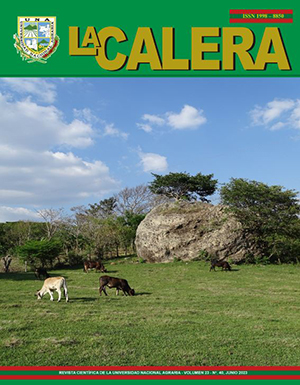Carbon stored in agroforestry systems with coffee (Coffea arabica L.) in three municipalities of Boaco, Nicaragua
DOI:
https://doi.org/10.5377/calera.v23i40.16221Keywords:
Agroforestry systems, greenhouse gas, coffee farming, agroecologyAbstract
Most of the coffee production in Nicaragua is grown under shade, which allows the capture of significant volumes of carbon from the atmosphere that, under the concept of payment for environmental services, would mean the generation of other income for the producer. The objective was to calculate the volumes of carbon stored by trees, coffee bushes, mulch and soil in the agroforestry system with coffee and estimate its economic value. The research was non-experimental under a methodological process of three phases: planning, execution and analysis and interpretation of results; The sample was selected based on criteria defined by the Union of Cooperatives, among them: leading producer in his community, altitudinal floor between 600 and 900 m, producer open to communication and who applied the training provided by the Cooperative, the sample It was composed of two agroforestry systems close to 900 masl and two close to 600 masl. A single sampling plot of 0.25 ha was used to whose sampled trees and shrubs allometric equations were applied, the mulch was subjected to moisture discount, dry matter was obtained from them and the carbon factor of 0.5 was applied. For the soil, apparent density (g cm-3) and organic carbon (%) were determined to be used in the formula of Andrade and Ibrahim, 2003. The soil component was the one that presented the highest average volume of stored carbon with 80.86 t C ha-1 followed by trees, mulch and coffee bushes with 15.58, 6.21 and 1.22 t C ha-1 respectively. The agroforestry systems with the highest and lowest volume of carbon stored were Los Chilamates and Las Quebradas with 119.22 and 89.01 t C ha-1. Based on the carbon stored, producers could receive other income from carbon capture from 874.36 to 652.80 US dollars per hectare. based on stored CO2. It is recommended to carry out the study with a greater number of producers and have relevant base information to manage the carbon storage payment project.
Downloads
94
HTML (Español (España)) 75
EPUB (Español (España)) 39
Published
How to Cite
Issue
Section
License
Copyright (c) 2023 Universidad Nacional Agraria

This work is licensed under a Creative Commons Attribution-NonCommercial-ShareAlike 4.0 International License.

